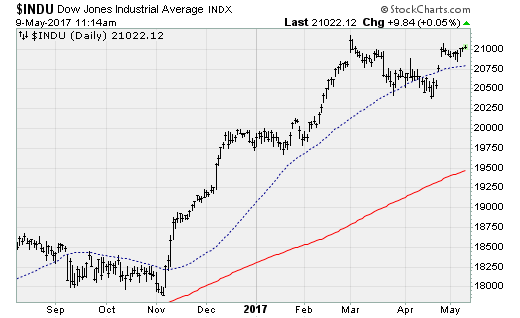Don't let Wall Street's sleepy calm fool you
U.S. equities stuck with their uneasy stasis on Tuesday, keeping the Dow Jones industrials index locked near the 21,000 level in one of the tightest trading ranges in decades (chart below).
Sure, you can find excitement if you know where to look. Witness the surge in big tech stocks like Apple (AAPL) to new record highs, thanks to positive comments from Warren Buffett, growing iPhone 8 hype and predictions of a $1 trillion market capitalization from Wall Street analysts.
But outside of key big tech and financial stocks, selling pressure is actually accumulating. As the number of new 52-week lows grew on both the New York Stock Exchange and Nasdaq exchanges last Thursday, the "Hindenburg Omen" was triggered. Although often derided by the optimists as scary sounding but ultimately useless, this signal has presaged exceedingly poor market returns when both exchanges have triggered it.
The Hindenburg Omen's calculations are somewhat complicated, but the logic behind the signal is this: In a normal uptrend, a healthy number of stocks should be setting new highs. As an uptrend matures and starts to decay, one of the first warning signals is an rise in the number of new lows being set simultaneously with new highs.
It's akin to a house in a flood, with its foundation being washed away.
For every stock like AAPL, many others are struggling, especially in the energy and retail sectors. Macy's (M) is 35 percent below its 52-week high. Target (TGT) is down 26.5 percent. Ford (F) is down 17 percent. Exxon Mobil (XOM) down 11 percent.
Overall, just 57 percent of the stocks in the NYSE are above their 50-day moving averages and in uptrends. Compare that to the high of 83 percent set in early January when the Dow was still trading below the 20,000 level.
The level of investor complacency being demonstrated is reaching an extreme. With valuations high and the CBOE Volatility Index (VIX) crushed, the ratio of the S&P 500's price-earnings ratio relative to the VIX has hit levels of euphoria not seen since 1994.
SentimenTrader's Risk Appetite Index -- which is based on an amalgam of indicators including the Citigroup Macro Risk Index and the UBS G10 Carry Risk Index Plus, among others -- is nearing 100 percent and has been unusually high.
Historically, stocks have demonstrated mixed performances in similar circumstances, with "defensive" assets like Treasury bonds, commodities, gold and the VIX doing better.
Another worry has been the very weak market breadth as fewer and fewer stocks hold the market in its sideways stasis. And there's a growing list of downright oddities, such as the Dow not having a three-day winning streak in roughly 50 days, one of the longest streaks in more than 100 years, even though it's in a bull market.
Then there's that Hindenburg Omen getting triggered. On such occasions since 1986, based on SentimenTrader data, the S&P 500 has gone on to lose an average of 5.1 percent three months later vs. a 2.5 percent gain for any random three-month period.
The largest drawdown? The three months following the Sept. 23, 1987, Hindenburg Omen, which featured a 22.2 percent decline.





